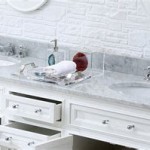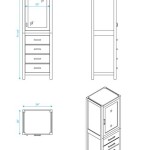How Much Does A Remodeled Bathroom Add Value To Your Home?
Remodeling a bathroom is a common home improvement project undertaken by homeowners seeking to modernize their living space, increase functionality, and potentially boost the resale value of their property. While the aesthetic appeal and personal enjoyment aspects are undeniable, the financial implications of a bathroom remodel, particularly its impact on home value, are crucial considerations. Determining how much a remodeled bathroom adds to a home's value involves a multifaceted analysis, considering factors such as the scope of the remodel, the quality of materials used, the overall condition of the home, and the prevailing market conditions.
Generally, a well-executed bathroom remodel can offer a significant return on investment (ROI). However, the actual increase in home value is not always a dollar-for-dollar recoupment of the remodeling costs. ROI figures often fluctuate based on the aforementioned variables. Understanding these factors is paramount for homeowners planning a bathroom remodel with the intention of enhancing their home's worth.
Scope and Nature of the Remodel
The extent of the bathroom remodel plays a significant role in determining the value added to the home. A minor remodel, involving cosmetic upgrades like replacing the toilet, sink, or vanity, typically yields a different ROI compared to a major overhaul. A major remodel often encompasses a complete restructuring of the bathroom layout, including moving plumbing fixtures, replacing flooring, and installing new tile. These more extensive projects tend to be more expensive but can also lead to a greater increase in home value, especially if the existing bathroom was significantly outdated or dysfunctional.
A minor remodel might focus on updating the aesthetics without altering the core functionality. This could involve repainting the walls, replacing outdated hardware (such as faucets and showerheads), and installing a new mirror or lighting fixtures. These changes can significantly improve the bathroom's appearance and make it more appealing to potential buyers, but they are unlikely to command a substantial increase in home value.
On the other hand, a major remodel could involve gutting the entire bathroom and starting from scratch. This allows for a complete redesign, incorporating features like a walk-in shower, a soaking tub, or dual vanities. Such comprehensive renovations address not only the aesthetic aspects but also the functional and structural aspects of the bathroom. The increased functionality and modern amenities are often highly valued by potential buyers, contributing to a more significant increase in the home's overall worth.
The addition of a new bathroom also falls under the umbrella of significant remodeling efforts. Adding a bathroom, particularly in a home with limited bathrooms relative to the number of bedrooms, can substantially increase its value. A half-bath (powder room) can be added relatively easily, while a full bath requires more extensive plumbing and space considerations. This type of remodel often requires permits and adherence to building codes, further adding to the complexity and cost, but the resulting increase in convenience and marketability can be substantial.
Quality of Materials and Workmanship
The quality of materials used and the level of workmanship employed during the bathroom remodel directly impact the perceived value and longevity of the renovation. Using high-end materials, such as premium tiles, durable countertops, and energy-efficient fixtures, can significantly elevate the bathroom's aesthetic appeal and functionality. Conversely, using cheap or low-quality materials can detract from the overall impression and potentially lead to maintenance issues down the line, negatively affecting the perceived value.
The choice of materials should align with the overall style and quality of the home. In a high-end home, using luxury materials like marble countertops, designer fixtures, and custom cabinetry is expected. However, in a more modest home, using mid-range materials that offer a balance of durability and affordability may be a more appropriate choice. Over-improving a bathroom with excessively expensive materials in a home that doesn't warrant it can lead to diminished returns.
Similarly, the workmanship involved in the remodel is crucial. Hiring qualified and experienced contractors ensures that the work is done correctly and to code. Poor workmanship, such as improperly installed tiles, leaky plumbing, or uneven surfaces, can detract from the bathroom's appearance and functionality, ultimately reducing its value. Properly executed projects will stand the test of time and are more appealing to potential buyers.
Furthermore, ensuring compliance with local building codes and regulations is essential. Non-compliant work can lead to costly repairs in the future and can even hinder the sale of the home. Obtaining the necessary permits and inspections ensures that the remodel meets safety standards and is legally compliant.
Market Conditions and Location
Local market conditions and the home's location play a significant role in determining the value added by a bathroom remodel. In a seller's market, where demand for homes is high and supply is limited, even minor bathroom upgrades can help a home stand out and potentially command a higher price. Conversely, in a buyer's market, where there is an oversupply of homes, a more extensive and well-executed bathroom remodel may be necessary to attract attention and increase the home's value.
The location of the home also influences the desirability of certain bathroom features. For example, in areas with a large senior population, features like walk-in showers and grab bars may be highly valued. In family-oriented neighborhoods, features like double vanities and a separate toilet area may be more appealing. Understanding the preferences of potential buyers in the specific location is crucial for making informed remodeling decisions.
The overall condition of the home and its neighborhood also impact the perceived value of a remodeled bathroom. If the home is in disrepair or located in a less desirable neighborhood, a high-end bathroom remodel may not yield as significant a return as it would in a well-maintained home in a desirable location. Buyers often consider the overall package, and a single upgraded bathroom cannot compensate for other deficiencies in the property.
Analyzing comparable sales in the area (comps) can provide valuable insights into the impact of bathroom remodels on home values. By comparing the sale prices of similar homes with and without updated bathrooms, homeowners can gain a better understanding of the potential ROI for their project. Real estate professionals can assist in conducting this analysis and providing informed advice on the most effective remodeling strategies.
The current design trends also play a role. Bathrooms that are modern and stylish are more likely to attract buyers. Neutral color palettes, clean lines, and energy-efficient fixtures are generally well-received. Staying informed about current trends and incorporating them into the remodel can increase the appeal and value of the bathroom.
Return on Investment (ROI) Considerations
Calculating the return on investment (ROI) for a bathroom remodel involves comparing the cost of the remodel to the increase in the home's selling price attributable to the remodel. This calculation is not always straightforward, as it can be difficult to isolate the impact of the bathroom remodel from other factors that influence home value, such as market conditions and the overall condition of the home. However, by carefully analyzing comparable sales and consulting with real estate professionals, homeowners can make a reasonable estimate of the potential ROI.
Various real estate and remodeling publications provide data on average ROI for bathroom remodels. These figures should be used as general guidelines, as the actual ROI can vary significantly based on the specific factors mentioned earlier. It's important to remember that ROI is not the only factor to consider. Homeowners may also prioritize the personal enjoyment and functionality of the remodeled bathroom, even if the ROI is not exceptionally high.
Cost-effective remodeling strategies can help maximize the ROI. This may involve focusing on cosmetic upgrades rather than structural changes, choosing affordable materials without sacrificing quality, and performing some of the work themselves (if experienced and qualified). Careful planning and budgeting are essential for keeping costs under control and ensuring that the remodel adds value to the home.
Conversely, overspending on unnecessary features or luxury materials can diminish the ROI. It's important to strike a balance between personal preferences and the potential impact on home value. Consulting with a real estate professional before embarking on a bathroom remodel can help homeowners make informed decisions about which upgrades are most likely to increase their home's value.
Beyond the financial ROI, homeowners should also consider the less tangible benefits of a remodeled bathroom, such as increased comfort, convenience, and enjoyment of their living space. A well-designed and functional bathroom can improve the quality of life and make the home more appealing to live in. These personal benefits can be just as important as the financial return on investment.

Best Worst Renovations To Add Value Your Property
How Much Value Does A Bathroom Remodel Add Modern

How Much Does An Extra Bathroom Add To The Value Of A House Resi

Kitchen Bathroom Remodels That Increase Home Value Homeadvisor

6 Bathroom Remodeling Ideas That Add Value To Your Home

How A Bathroom Remodel Can Add Value To Your Home Mountain Empire Stoneworks

Adding Value To Your Home With Kitchen And Bathroom Remodels A S P Mortgage Corporation

Can Bathroom Remodel Increase Home Value

Will A Bathroom Renovation Add Value To Your Home

Just How Much Does A Bathroom Renovation Add Value To Your Home Oxford Bathrooms
Related Posts







